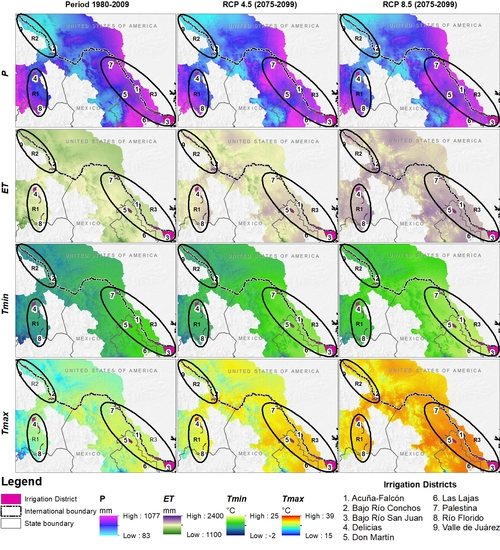Impacts of Climate Change on the Irrigation Districts of the Rio Bravo Basin
Abstract
:1. Introduction
2. Materials and Methods
2.1. Study Area
2.2. Database of Past Climate Data
2.3. Analysis and Projection of Climate Data
3. Results
3.1. Changes in Climate Conditions
3.2. Aridity Index and Precipitation Minus Evapotranspiration
3.3. Potential Impact on the Irrigation Districts
4. Conclusions
Acknowledgments
Author Contributions
Conflicts of Interest
Appendix A
| ID | Crop | Harvested Surface | Yield (Ton/ha) | Production Value | ||
|---|---|---|---|---|---|---|
| ha | % 1 | Thousand USD 2 | % 3 | |||
| Acuña-Falcón | Green buffel | 1168.0 | 54.35% | 41.9 | 6117.11 | 53.67% |
| Acuña-Falcón | Sweet sorghum | 540.0 | 25.13% | 34.5 | 2328.57 | 20.43% |
| Acuña-Falcón | Walnut | 287.0 | 13.36% | 1.7 | 2386.36 | 20.94% |
| Acuña-Falcón | Green oat | 64.0 | 2.98% | 25.0 | 161.72 | 1.42% |
| Acuña-Falcón | Field corn | 60.0 | 2.79% | 4.3 | 55.71 | 0.49% |
| Acuña-Falcón | Watermelon | 30.0 | 1.40% | 46.0 | 348.70 | 3.06% |
| Bajo Río Conchos | Green alfalfa | 1428.5 | 38.66% | 84.0 | 4191.83 | 30.30% |
| Bajo Río Conchos | Cotton | 649.3 | 17.57% | 4.8 | 2276.35 | 16.45% |
| Bajo Río Conchos | Sweet sorghum | 513.2 | 13.89% | 71.2 | 810.44 | 5.86% |
| Bajo Río Conchos | Green oat | 366.6 | 9.92% | 31.0 | 503.98 | 3.64% |
| Bajo Río Conchos | Walnut | 248.6 | 6.73% | 2.8 | 4749.00 | 34.33% |
| Bajo Río Conchos | Rye grass | 239.3 | 6.48% | 75.0 | 1009.05 | 7.29% |
| Bajo Río Conchos | Wheat | 175.5 | 4.75% | 4.3 | 171.61 | 1.24% |
| Bajo Río Conchos | Small vegetables | 59.3 | 1.60% | 8.5 | 111.45 | 0.81% |
| Bajo Río Conchos | Field corn | 14.0 | 0.38% | 1.4 | 3.82 | 0.03% |
| Bajo Río Conchos | Melon | 1.0 | 0.03% | 27.5 | 6.51 | 0.05% |
| Bajo Río San Juan | Field corn | 55,493.3 | 82.75% | 7.4 | 85,395.36 | 88.63% |
| Bajo Río San Juan | Grain sorghum | 10,351.9 | 15.44% | 4.1 | 8048.74 | 8.35% |
| Bajo Río San Juan | Cotton | 893.2 | 1.33% | 2.7 | 1951.07 | 2.02% |
| Bajo Río San Juan | Green buffel | 145.0 | 0.22% | 5.5 | 60.58 | 0.06% |
| Bajo Río San Juan | Popcorn maize | 59.0 | 0.09% | 4.0 | 95.67 | 0.10% |
| Bajo Río San Juan | Soy | 41.1 | 0.06% | 3.1 | 60.04 | 0.06% |
| Bajo Río San Juan | Bermuda for hay | 24.0 | 0.04% | 6.5 | 11.83 | 0.01% |
| Bajo Río San Juan | Sweet sorghum | 15.0 | 0.02% | 20.0 | 18.57 | 0.02% |
| Bajo Río San Juan | Green alfalfa | 14.0 | 0.02% | 17.3 | 53.39 | 0.06% |
| Bajo Río San Juan | Watermelon | 9.0 | 0.01% | 20.0 | 39.80 | 0.04% |
| Bajo Río San Juan | Cucumber | 6.0 | 0.01% | 50.0 | 180.99 | 0.19% |
| Bajo Río San Juan | Melon | 5.0 | 0.01% | 20.0 | 23.25 | 0.02% |
| Bajo Río San Juan | Eggplant | 3.0 | 0.00% | 80.0 | 333.54 | 0.35% |
| Bajo Río San Juan | Green chile | 3.0 | 0.00% | 20.0 | 26.53 | 0.03% |
| Bajo Río San Juan | Green tomato | 2.4 | 0.00% | 36.0 | 52.40 | 0.05% |
| Delicias | Green alfalfa | 28,657.7 | 46.64% | 58.7 | 79,700.21 | 25.31% |
| Delicias | Walnut | 9809.8 | 15.97% | 1.7 | 84,278.68 | 26.76% |
| Delicias | Green chile | 5370.4 | 8.74% | 40.0 | 71,922.10 | 22.84% |
| Delicias | Field corn | 5290.7 | 8.61% | 48.0 | 10,427.72 | 3.31% |
| Delicias | Groundnut (peanut) | 4642.2 | 7.56% | 2.5 | 7441.35 | 2.36% |
| Delicias | Watermelon | 3874.0 | 6.31% | 50.0 | 23,273.37 | 7.39% |
| Delicias | Onion | 1775.5 | 2.89% | 70.0 | 21,198.68 | 6.73% |
| Delicias | Other crops | 1225.0 | 1.99% | 35.0 | 14,896.56 | 4.73% |
| Delicias | Cotton | 796.6 | 1.30% | 3.5 | 1773.49 | 0.56% |
| Don Martín | Wheat | 1198.0 | 26.16% | 4.5 | 1359.16 | 13.56% |
| Don Martín | Green buffel | 875.1 | 19.11% | 40.7 | 4454.84 | 44.43% |
| Don Martín | Grain sorghum | 836.2 | 18.26% | 4.2 | 713.65 | 7.12% |
| Don Martín | Soy | 684.5 | 14.95% | 3.1 | 1190.94 | 11.88% |
| Don Martín | Corn | 517.5 | 11.30% | 4.3 | 481.23 | 4.80% |
| Don Martín | Sweet sorghum | 376.7 | 8.22% | 34.5 | 1625.41 | 16.21% |
| Don Martín | Sorghum foy hay | 51.0 | 1.11% | 1.1 | 84.34 | 0.84% |
| Don Martín | Green oat | 21.0 | 0.46% | 24.1 | 51.17 | 0.51% |
| Don Martín | Rye grass | 20.0 | 0.44% | 29.1 | 66.18 | 0.66% |
| Las Lajas | Grain sorghum | 594.0 | 36.86% | 3.8 | 417.84 | 39.65% |
| Las Lajas | Green buffel | 446.3 | 27.69% | 3.9 | 131.96 | 12.52% |
| Las Lajas | Corn | 388.7 | 24.12% | 4.0 | 324.11 | 30.76% |
| Las Lajas | Sweet sorghum | 105.2 | 6.53% | 4.4 | 73.61 | 6.99% |
| Las Lajas | Soy | 77.3 | 4.80% | 2.9 | 106.18 | 10.08% |
| Palestina | Sweet sorghum | 1511.4 | 51.77% | 26.2 | 1358.40 | 54.29% |
| Palestina | Green oat | 450.8 | 15.44% | 21.6 | 385.26 | 15.40% |
| Palestina | Corn | 281.0 | 9.63% | 3.0 | 175.85 | 7.03% |
| Palestina | Klein grass | 171.5 | 5.87% | 31.2 | 185.91 | 7.43% |
| Palestina | Wheat | 162.0 | 5.55% | 3.0 | 107.68 | 4.30% |
| Palestina | Oat | 101.0 | 3.46% | 2.2 | 35.09 | 1.40% |
| Palestina | Bermuda for hay | 79.5 | 2.72% | 33.7 | 84.64 | 3.38% |
| Palestina | Rye grass | 47.5 | 1.63% | 24.2 | 47.22 | 1.89% |
| Palestina | Bean | 25.5 | 0.87% | 0.8 | 18.48 | 0.74% |
| Palestina | Green alfalfa | 25.0 | 0.86% | 35.1 | 41.60 | 1.66% |
| Palestina | Walnut | 22.5 | 0.77% | 0.8 | 28.43 | 1.14% |
| Palestina | Watermelon | 13.0 | 0.45% | 8.8 | 15.65 | 0.63% |
| Palestina | Green buffel | 11.0 | 0.38% | 24.5 | 8.51 | 0.34% |
| Palestina | Green triticale for hay | 11.0 | 0.38% | 16.1 | 5.92 | 0.24% |
| Palestina | Hay | 3.5 | 0.12% | 18.0 | 1.99 | 0.08% |
| Palestina | Sorghum for hay | 3.0 | 0.10% | 3.0 | 1.42 | 0.06% |
| Río Florido | Green alfalfa | 2578.0 | 55.20% | 40.0 | 3752.19 | 36.75% |
| Río Florido | Walnut | 594.0 | 12.72% | 1.0 | 3805.43 | 37.27% |
| Río Florido | Field corn | 539.0 | 11.54% | 45.0 | 766.11 | 7.50% |
| Río Florido | Sweet sorghum | 444.0 | 9.51% | 38.0 | 532.91 | 5.22% |
| Río Florido | Green oat | 284.0 | 6.08% | 38.0 | 340.87 | 3.34% |
| Río Florido | Green chile | 128.0 | 2.74% | 24.7 | 898.29 | 8.80% |
| Río Florido | Corn | 93.0 | 1.99% | 6.0 | 109.27 | 1.07% |
| Río Florido | Bean | 10.0 | 0.21% | 0.8 | 6.06 | 0.06% |
| Valle de Juárez | Green alfalfa | 2578.0 | 55.20% | 40.0 | 3752.19 | 36.75% |
| Valle de Juárez | Walnut | 594.0 | 12.72% | 1.0 | 3805.43 | 37.27% |
| Valle de Juárez | Field corn | 539.0 | 11.54% | 45.0 | 766.11 | 7.50% |
| Valle de Juárez | Sweet sorghum | 444.0 | 9.51% | 38.0 | 532.91 | 5.22% |
| Valle de Juárez | Green oat | 284.0 | 6.08% | 38.0 | 340.87 | 3.34% |
| Valle de Juárez | Green chile | 128.0 | 2.74% | 24.7 | 898.29 | 8.80% |
| Valle de Juárez | Corn | 93.0 | 1.99% | 6.0 | 109.27 | 1.07% |
| Valle de Juárez | Bean | 10.0 | 0.21% | 0.8 | 6.06 | 0.06% |
Appendix B
| Crop | Month | |||||||||||
|---|---|---|---|---|---|---|---|---|---|---|---|---|
| 1 | 2 | 3 | 4 | 5 | 6 | 7 | 8 | 9 | 10 | 11 | 12 | |
| Green alfalfa | 0.65 | 0.95 | 0.65 | 0.95 | 0.65 | 0.95 | 0.65 | 0.95 | 0.65 | 0.95 | 0.65 | 0.95 |
| Cotton | 0 | 0 | 0 | 0.35 | 0.75 | 1.2 | 1.2 | 0.5 | 0.5 | 0 | 0 | 0 |
| Green oat | 0 | 0 | 0 | 0.25 | 0.75 | 1.15 | 0.25 | 0 | 0 | 0 | 0 | 0 |
| Eggplant | 0.9 | 0 | 0 | 0 | 0 | 0 | 0 | 0 | 0 | 0.6 | 0.8 | 1.05 |
| Green bermuda | 0.55 | 1 | 1 | 0.85 | 0.55 | 1 | 1 | 0.85 | 0.55 | 1 | 1 | 0.85 |
| Green buffel | 0.55 | 1 | 1 | 0.85 | 0.55 | 1 | 1 | 0.85 | 0.55 | 1 | 1 | 0.85 |
| Groundnut (peanut) | 0 | 0 | 0 | 0 | 0.4 | 0.75 | 1.15 | 0.6 | 0 | 0 | 0 | 0 |
| Onion | 0 | 0 | 0 | 0 | 0 | 0 | 0 | 0 | 0 | 0.7 | 1 | 1 |
| Green chile | 1 | 1 | 1 | 0.8 | 0 | 0 | 0 | 0 | 0 | 0.15 | 0.6 | 1 |
| Bean | 0 | 0 | 0 | 0 | 0 | 0.4 | 1.15 | 0.35 | 0 | 0 | 0 | 0 |
| Green corn | 0 | 0 | 0 | 0 | 0 | 0 | 0 | 0 | 0 | 0.7 | 1.15 | 1.05 |
| Corn | 0 | 0 | 0 | 0.7 | 0.95 | 0.95 | 1.2 | 0.6 | 0 | 0 | 0 | 0 |
| Popcorn maize | 0 | 0 | 0 | 0 | 0 | 0 | 0 | 0 | 0 | 0.7 | 1.15 | 1.05 |
| Melon | 0 | 0 | 0.5 | 0.75 | 1.05 | 1.05 | 0.75 | 0 | 0 | 0 | 0 | 0 |
| Walnut | 0 | 0 | 0 | 0.5 | 1.1 | 1.1 | 1.1 | 1.1 | 0.65 | 0 | 0 | 0 |
| Small vegetables | 0 | 0 | 0 | 0.7 | 0.85 | 1 | 0.85 | 0 | 0 | 0 | 0 | 0 |
| Other crops | 0 | 0 | 0 | 0.7 | 1.05 | 0.8 | 0 | 0 | 0 | 0 | 0 | 0 |
| Grass | 0.75 | 0.75 | 0.75 | 0.75 | 0.75 | 0.75 | 0.75 | 0.75 | 0.75 | 0.75 | 0.75 | 0.75 |
| Cucumber | 0 | 0.6 | 0.8 | 1 | 0.75 | 0 | 0 | 0 | 0 | 0 | 0 | 0 |
| Rye grass | 5 | 0.55 | 1 | 1 | 0.85 | 0.55 | 1 | 1 | 0.85 | 0.55 | 1 | 1 |
| Watermelon | 0 | 0 | 0 | 0.4 | 0.52 | 1 | 0.75 | 0 | 0 | 0 | 0 | 0 |
| Sorghum for hay | 0 | 0 | 0 | 0.7 | 0.85 | 1 | 0.8 | 0 | 0 | 0 | 0 | 0 |
| Green sorghum | 0 | 0 | 0 | 0.7 | 0.85 | 1 | 0.8 | 0 | 0 | 0 | 0 | 0 |
| Grain sorghum | 0 | 0 | 0 | 0.7 | 0.85 | 1 | 0.8 | 0 | 0 | 0 | 0 | 0 |
| Soy | 0 | 0 | 0 | 0 | 0.5 | 0.8 | 1.15 | 1.15 | 0.5 | 0 | 0 | 0 |
| Green sudan | 0.7 | 0.7 | 0.7 | 0.7 | 0.7 | 0.7 | 0.7 | 0.7 | 0.7 | 0.7 | 0.7 | 0.7 |
| Green tomato | 0.6 | 0.85 | 1.15 | 1.15 | 0.9 | 0 | 0 | 0 | 0 | 0 | 0 | 0 |
| Wheat | 0.75 | 0.75 | 1.15 | 1.15 | 0.4 | 0 | 0 | 0 | 0 | 0 | 0 | 0.4 |
References
- Thornton, P.; Thornton, M.; Mayer, B.; Wei, Y.; Devarakonda, R.; Vose, R.; Cook, R. Daymet: Daily Surface Weather Data on a 1-km Grid for North America, Version 3; ORNL DAAC: Oak Ridge, TN, USA, 2017. [Google Scholar]
- Becerril-Piña, R.; Díaz-Delgado, C.; Mastachi-Loza, C.A.; González-Sosa, E. Integration of remote sensing techniques for monitoring desertification in Mexico. Hum. Ecol. Risk Assess. Int. J. 2016, 22, 1323–1340. [Google Scholar] [CrossRef]
- Vilchis-Francés, A.Y.; Díaz-Delgado, C.; Magaña-Lona, D.; Bâ, K.M.; Gómez-Albores, M.Á. Modelado espacial para peligro de incendios forestales con predicción diaria en la cuenca del río Balsas. Agrociencia 2015, 49, 803–820. [Google Scholar]
- Cervantes-Jiménez, M.; Mastachi-Loza, C.A.; Díaz-Delgado, C.; Gómez-Albores, M.Á.; González-Sosa, E. Socio-Ecological regionalization of the urban sub-casins in Mexico. Water 2017, 9, 14. [Google Scholar] [CrossRef]
- Ouarda, T.; Bâ, K.; Diaz-Delgado, C.; Cârsteanu, A.; Chokmani, K.; Gingras, H.; Quentin, E.; Trujillo, E.; Bobée, B. Intercomparison of regional flood frequency estimation methods at ungauged sites for a Mexican case study. J. Hydrol. 2008, 348, 40–58. [Google Scholar] [CrossRef]
- Mastachi-Loza, C.A.; Becerril-Piña, R.; Gómez-Albores, M.A.; Díaz-Delgado, C.; Romero-Contreras, A.T.; Garcia-Aragon, J.A.; Vizcarra-Bordi, I. Regional analysis of climate variability at three time scales and its effect on rainfed maize production in the Upper Lerma River Basin, Mexico. Agric. Ecosyst. Environ. 2016, 225, 1–11. [Google Scholar] [CrossRef]
- Ortiz-Partida, J.P.; Sandoval-Solis, S.; Arellano González, J.; Medellín-Azuara, J.; Taylor, J.E. Managing Water Differently: Integrated Water Resources Management as a Framework for Adaptation to Climate Change in Mexico; University of California: Oakland, CA, USA, 2017. [Google Scholar]
- Stocker, T.F.; Qin, D.; Plattner, G.-K.; Tignor, M.; Allen, S.K.; Boschung, J.; Nauels, A.; Xia, Y.; Bex, V.; Midgley, P.M. Climate Change 2013: The Physical Science Basis. Intergovernmental. Panel Climate Change Working Group Contribution IPCC Fifth Assessment Report AR5; Cambridge University Press: New York, NY, USA, 2013. [Google Scholar]
- Arreguín, F.; López, M.; Rodríguez, O.; Montero, M. Atlas de Vulnerabilidad Hídrica en México ante el Cambio Climático; IMTA: Jiutepec, Mexico, 2015; ISBN 978-607-9368-07-4. [Google Scholar]
- Woznicki, S.A.; Nejadhashemi, A.P.; Parsinejad, M. Climate change and irrigation demand: Uncertainty and adaptation. J. Hydrol. Reg. Stud. 2015, 3, 247–264. [Google Scholar] [CrossRef]
- Kang, Y.; Khan, S.; Ma, X. Climate change impacts on crop yield, crop water productivity and food security—A review. Prog. Nat. Sci. 2009, 19, 1665–1674. [Google Scholar] [CrossRef]
- Ringler, C.; Karelina, Z.; Pandya-Lorch, R. Emerging country strategies for improving food security: Linkages and trade-offs for water and energy security. In Proceedings of the Bonn 2011 Conference, Bonn, Germany, 16–18 November 2011; Volume 17. [Google Scholar]
- Nematian, J. An Extended Two-stage stochastic programming approach for water resources management under uncertainty. J. Environ. Inform. 2016, 27, 72–84. [Google Scholar] [CrossRef]
- Hatfield, J.L.; Boote, K.J.; Kimball, B.A.; Ziska, L.H.; Izaurralde, R.C.; Ort, D.; Thomson, A.M.; Wolfe, D. Climate impacts on agriculture: Implications for crop production. Agron. J. 2011, 103, 351–370. [Google Scholar] [CrossRef]
- Bita, C.; Gerats, T. Plant tolerance to high temperature in a changing environment: Scientific fundamentals and production of heat stress-tolerant crops. Front. Plant Sci. 2013, 4, 273. [Google Scholar] [CrossRef] [PubMed] [Green Version]
- Clark, J.S.; Melillo, J.; Mohan, J.; Salk, C. The seasonal timing of warming that controls onset of the growing Season. Glob. Chang. Biol. 2014, 20, 1136–1145. [Google Scholar] [CrossRef] [PubMed]
- Prasad, P.; Djanaguiraman, M.; Perumal, R.; Ciampitti, I.A. Impact of high temperature stress on floret fertility and individual grain weight of grain sorghum: Sensitive stages and thresholds for temperature and duration. Front. Plant Sci. 2015, 6, 820. [Google Scholar] [CrossRef] [PubMed] [Green Version]
- Anwar, M.R.; Liu, D.L.; Farquharson, R.; Macadam, I.; Abadi, A.; Finlayson, J.; Wang, B.; Ramilan, T. Climate change impacts on phenology and yields of five broadacre crops at four climatologically distinct locations in Australia. Agric. Syst. 2015, 132, 133–144. [Google Scholar] [CrossRef]
- Li, Z.; Yang, P.; Tang, H.; Wu, W.; Yin, H.; Liu, Z.; Zhang, L. Response of maize phenology to climate warming in Northeast China between 1990 and 2012. Reg. Environ. Chang. 2014, 14, 39–48. [Google Scholar] [CrossRef]
- Liu, Y.; Chen, Q.; Ge, Q.; Dai, J.; Qin, Y.; Dai, L.; Zou, X.; Chen, J. Modelling the impacts of climate change and crop management on phenological trends of spring and winter wheat in China. Agric. For. Meteorol. 2018, 248, 518–526. [Google Scholar] [CrossRef]
- Schlenker, W.; Roberts, M.J. Nonlinear temperature effects indicate severe damages to US crop yields under climate change. Proc. Natl. Acad. Sci. USA 2009, 106, 15594–15598. [Google Scholar] [CrossRef] [PubMed]
- Comisión Nacional del Agua (CONAGUA). Estadísticas del Agua en México 2016; Comisión Nacional del Agua-Secretaría del Medio Ambiente y Recursos Naturales: Mexico City, Mexico, 2016. [Google Scholar]
- Diario Oficial de la Federación (DOF). Plan Nacional de Desarrollo 2013–2018; Gobierno de la República: Mexico City, Mexico, 2013. [Google Scholar]
- Galindo, L.M.; Reyes, O. Climate change, irrigation and agricultural activities in Mexico: A Ricardian analysis with panel data. J. Dev. Agric. Econ. 2015, 7, 262–273. [Google Scholar]
- Mendelsohn, R.; Wang, J. The impact of climate on farm inputs in developing countries agriculture. Atmósfera 2017, 30, 77–86. [Google Scholar] [CrossRef]
- Food and Agriculture Organization (FAO). AQUASTAT Website. Available online: http://www.fao.org/nr/water/aquastat/main/indexesp.stm (accessed on 5 November 2017).
- Duran-Encalada, J.A.; Paucar-Caceres, A.; Bandala, E.; Wright, G. The impact of global climate change on water quantity and quality: A system dynamics approach to the US–Mexican transborder region. Eur. J. Oper. Res. 2017, 256, 567–581. [Google Scholar] [CrossRef]
- Mundo-Molina, M. Estandarización de las ecuaciones para estimar la evapotranspiración del cultivo de referencia. Ing. Investig. Tecnol. 2009, 10, 125–135. [Google Scholar]
- Wood, S.A.; Jina, A.S.; Jain, M.; Kristjanson, P.; DeFries, R.S. Smallholder farmer cropping decisions related to climate variability across multiple regions. Glob. Environ. Chang. 2014, 25, 163–172. [Google Scholar] [CrossRef]
- Pachauri, R.K.; Allen, M.R.; Barros, V.R.; Broome, J.; Cramer, W.; Christ, R.; Church, J.A.; Clarke, L.; Dahe, Q.; Dasgupta, P. Climate Change 2014: Synthesis Report. Contribution of Working Groups I, II and III to the Fifth Assessment Report of the Intergovernmental Panel on Climate Change; IPCC: Geneva, Switzerland, 2014; ISBN 92-9169-143-7. [Google Scholar]
- Comisión Nacional del Agua (CONAGUA). Estadísticas del Agua en México 2013; Comisión Nacional del Agua-Secretaría del Medio Ambiente y Recursos Naturales: Mexico City, Mexico, 2013. [Google Scholar]
- Eastman, J. TerrSet Tutorial; Clark Labs Clark University: Worcester, MA, USA, 2015. [Google Scholar]
- Wigley, T.M. MAGICC/SCENGEN 5.3: User Manual (Version 2); NCAR: Boulder, CO, USA, 2008; Volume 80. [Google Scholar]
- Demiroglu, O.C.; Turp, M.T.; Ozturk, T.; An, N.; Kurnaz, M.L. Technical climate change adaptation options of the major ski resorts in Bulgaria. In Sustainable Mountain Regions: Challenges and Perspectives in Southeastern Europe; Springer: Berlin, Germany, 2016; pp. 77–88. [Google Scholar]
- Hargreaves, G.H.; Samani, Z.A. Estimating potential evapotranspiration. J. Irrig. Drain. Div. 1982, 108, 225–230. [Google Scholar]
- Zomer, R.J.; Trabucco, A.; Bossio, D.A.; Verchot, L.V. Climate change mitigation: A spatial analysis of global land suitability for clean development mechanism afforestation and reforestation. Agric. Ecosyst. Environ. 2008, 126, 67–80. [Google Scholar] [CrossRef]
- Allen, R.G.; Pereira, L.S.; Raes, D.; Smith, M. Crop Evapotranspiration-Guidelines for Computing Crop Water Requirements-FAO Irrigation and Drainage Paper 56; FAO: Rome, Italy, 1998; Volume 300, p. D05109. [Google Scholar]
- Magaña, V. Informe Sobre Escenarios Futuros del Sector Agua en México Bajo Cambio Climático Para Las Climatologías del 2020, 2050 y 2080; Instituto Nacional de Ecología, Como Parte de los Trabajos de la 3a Comunicación Nacional: Mexico City, Mexico, 2006. [Google Scholar]
- Richards, J. Remote Sensing Digital Image Analysis; Springer: Berlin, Germany, 1999; Volume 3, ISBN 3-642-30061-8. [Google Scholar]
- Middleton, N.J.; Thomas, D.S. World atlas of Desertification; Wiley: Hoboken, NJ, USA, 1992. [Google Scholar]
- Byrne, M.P.; O’Gorman, P.A. The response of precipitation minus evapotranspiration to climate warming: Why the “wet-get-wetter, dry-get-drier” scaling does not hold over land. J. Clim. 2015, 28, 8078–8092. [Google Scholar] [CrossRef]
- Moorhead, J.E.; Gowda, P.H.; Singh, V.P.; Porter, D.O.; Marek, T.H.; Howell, T.A.; Stewart, B. Identifying and evaluating a suitable index for agricultural drought monitoring in the Texas high plains. JAWRA J. Am. Water Resour. Assoc. 2015, 51, 807–820. [Google Scholar] [CrossRef]
- Swenson, S.; Wahr, J. Estimating large-scale precipitation minus evapotranspiration from GRACE satellite gravity measurements. J. Hydrometeorol. 2006, 7, 252–270. [Google Scholar] [CrossRef]
- Nagarajan, S.; Jagadish, S.; Prasad, A.H.; Thomar, A.; Anand, A.; Pal, M.; Agarwal, P. Local climate affects growth, yield and grain quality of aromatic and non-aromatic rice in northwestern India. Agric. Ecosyst. Environ. 2010, 138, 274–281. [Google Scholar] [CrossRef]
- Jagadish, S.; Septiningsih, E.; Kohli, A.; Thomson, M.; Ye, C.; Redona, E.; Kumar, A.; Gregorio, G.; Wassmann, R.; Ismail, A. Genetic advances in adapting rice to a rapidly changing climate. J. Agron. Crop Sci. 2012, 198, 360–373. [Google Scholar] [CrossRef]
- Cammarano, D.; Tian, D. The effects of projected climate and climate extremes on a winter and summer crop in the southeast USA. Agric. For. Meteorol. 2018, 248, 109–118. [Google Scholar] [CrossRef]
- Estrella, N.; Sparks, T.H.; Menzel, A. Trends and temperature response in the phenology of crops in Germany. Glob. Chang. Biol. 2007, 13, 1737–1747. [Google Scholar] [CrossRef]
- Wang, J.; Wang, E.; Feng, L.; Yin, H.; Yu, W. Phenological trends of winter wheat in response to varietal and temperature changes in the North China Plain. Field Crop. Res. 2013, 144, 135–144. [Google Scholar] [CrossRef]
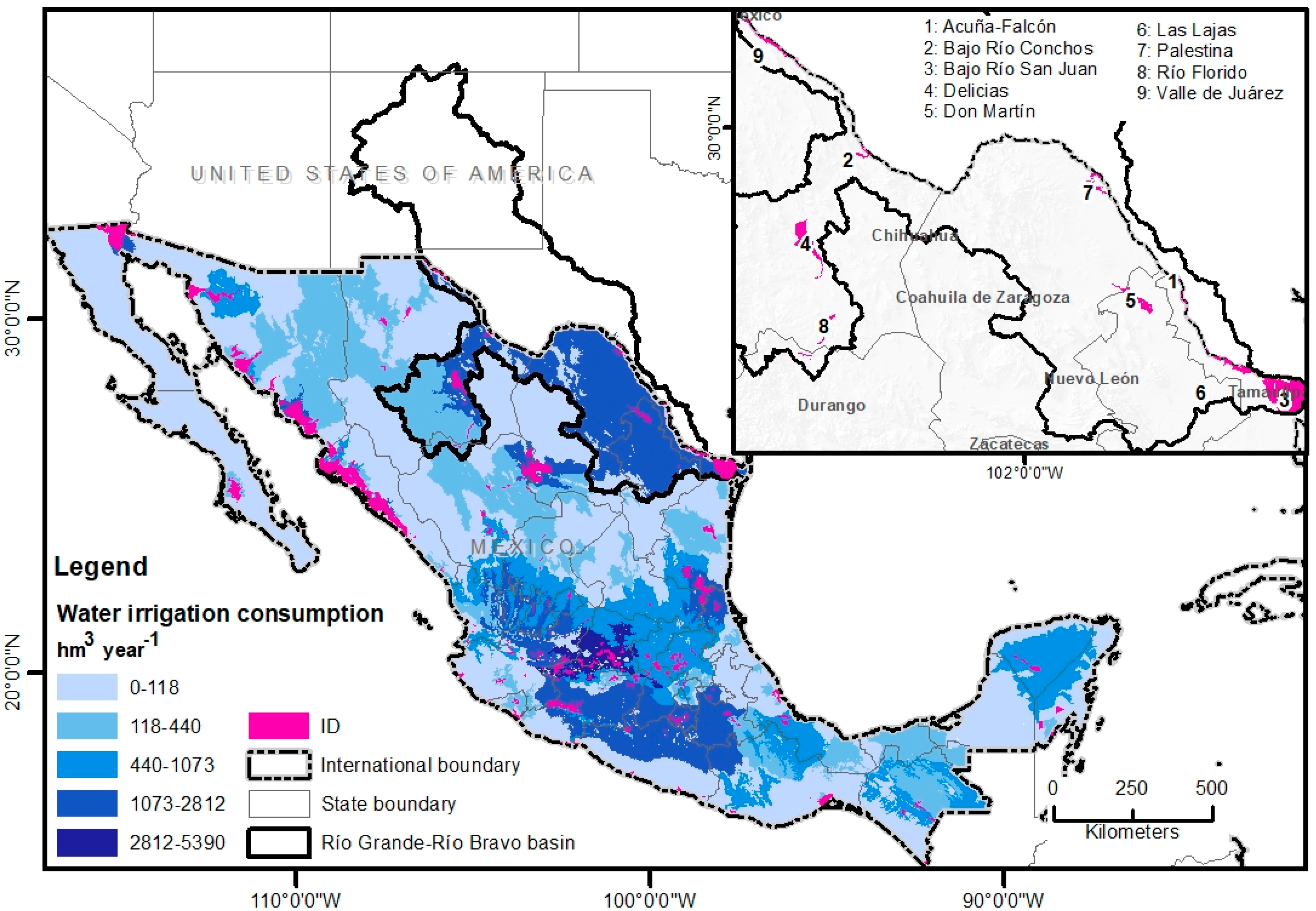
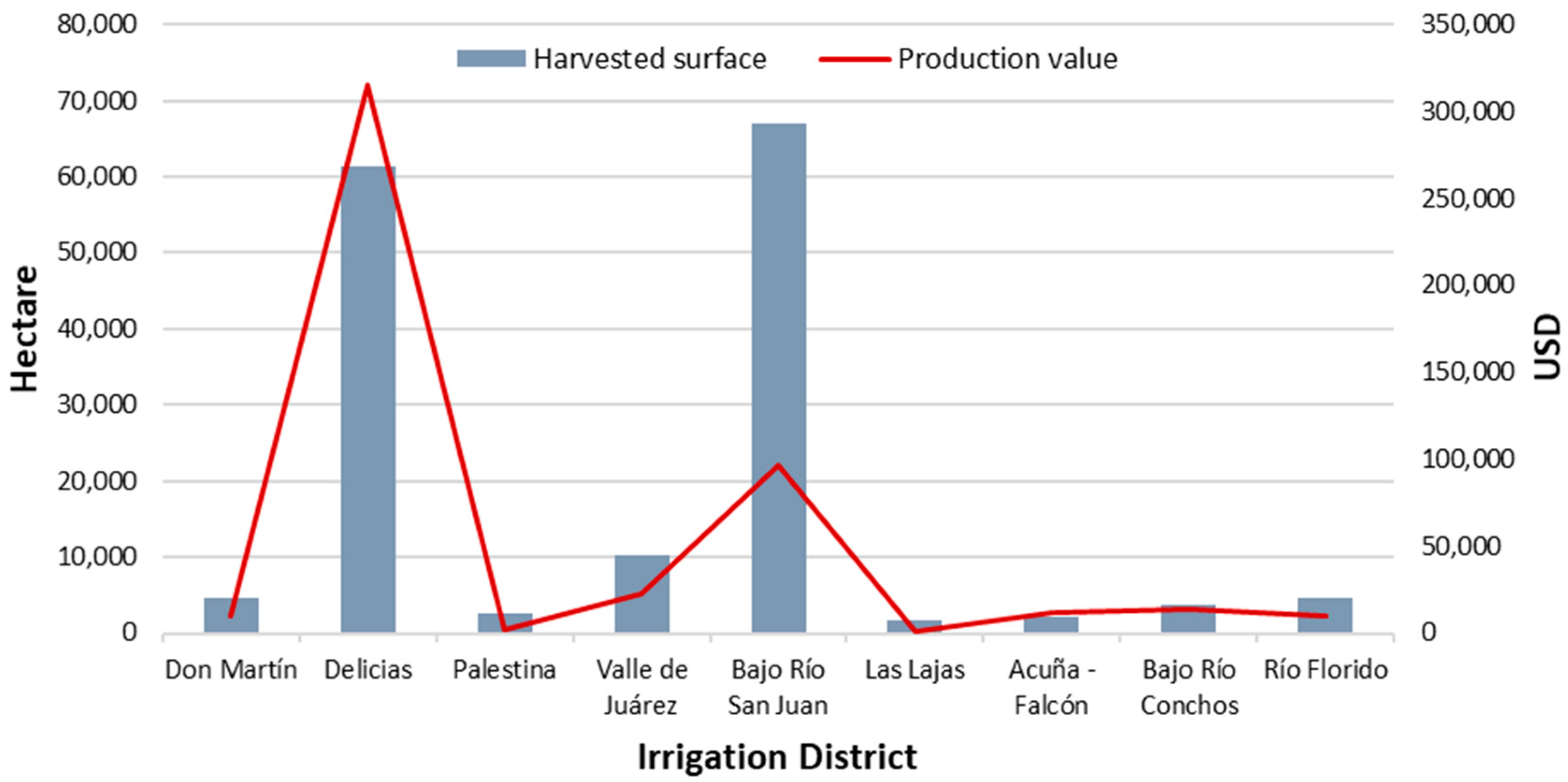
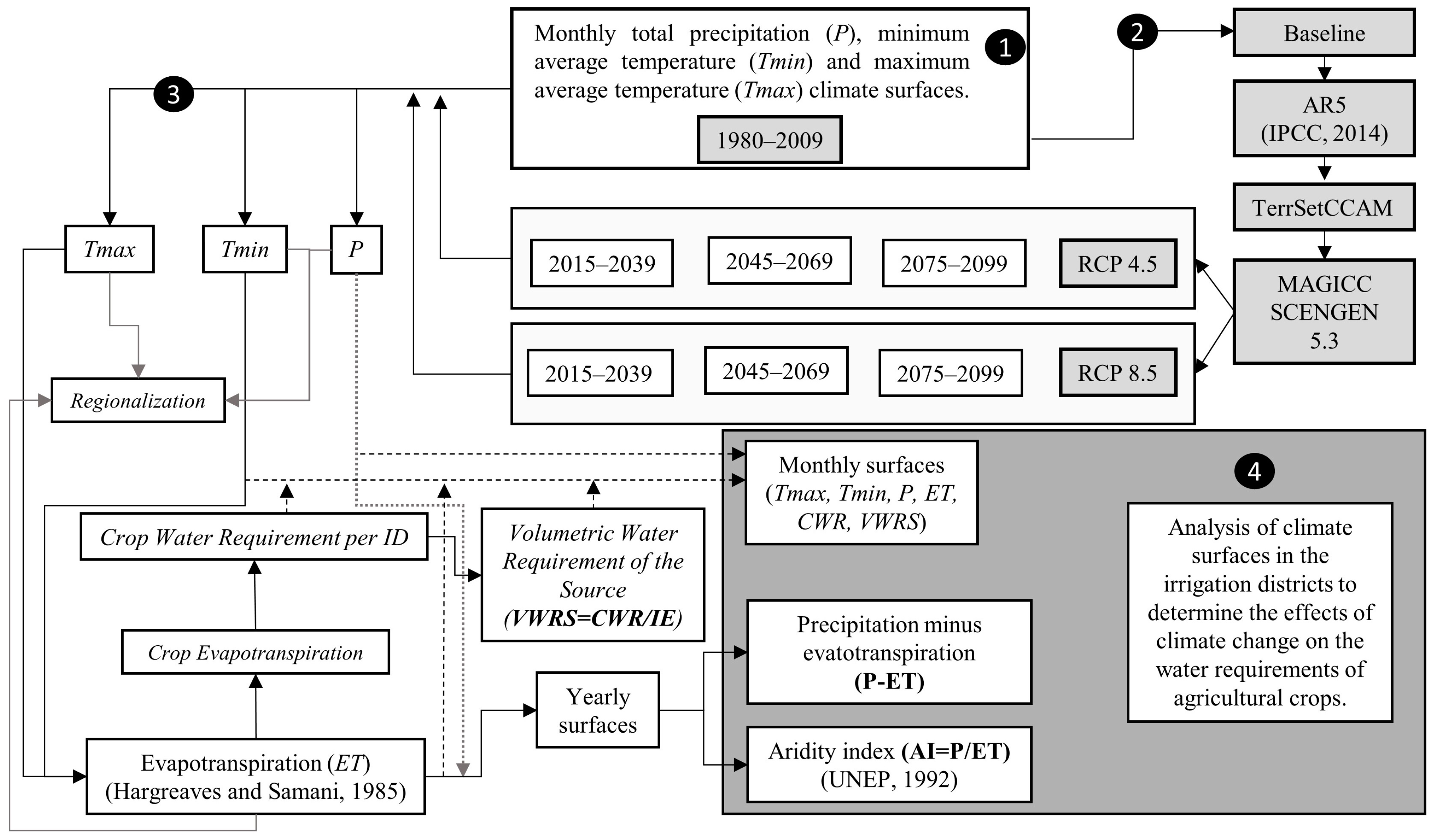
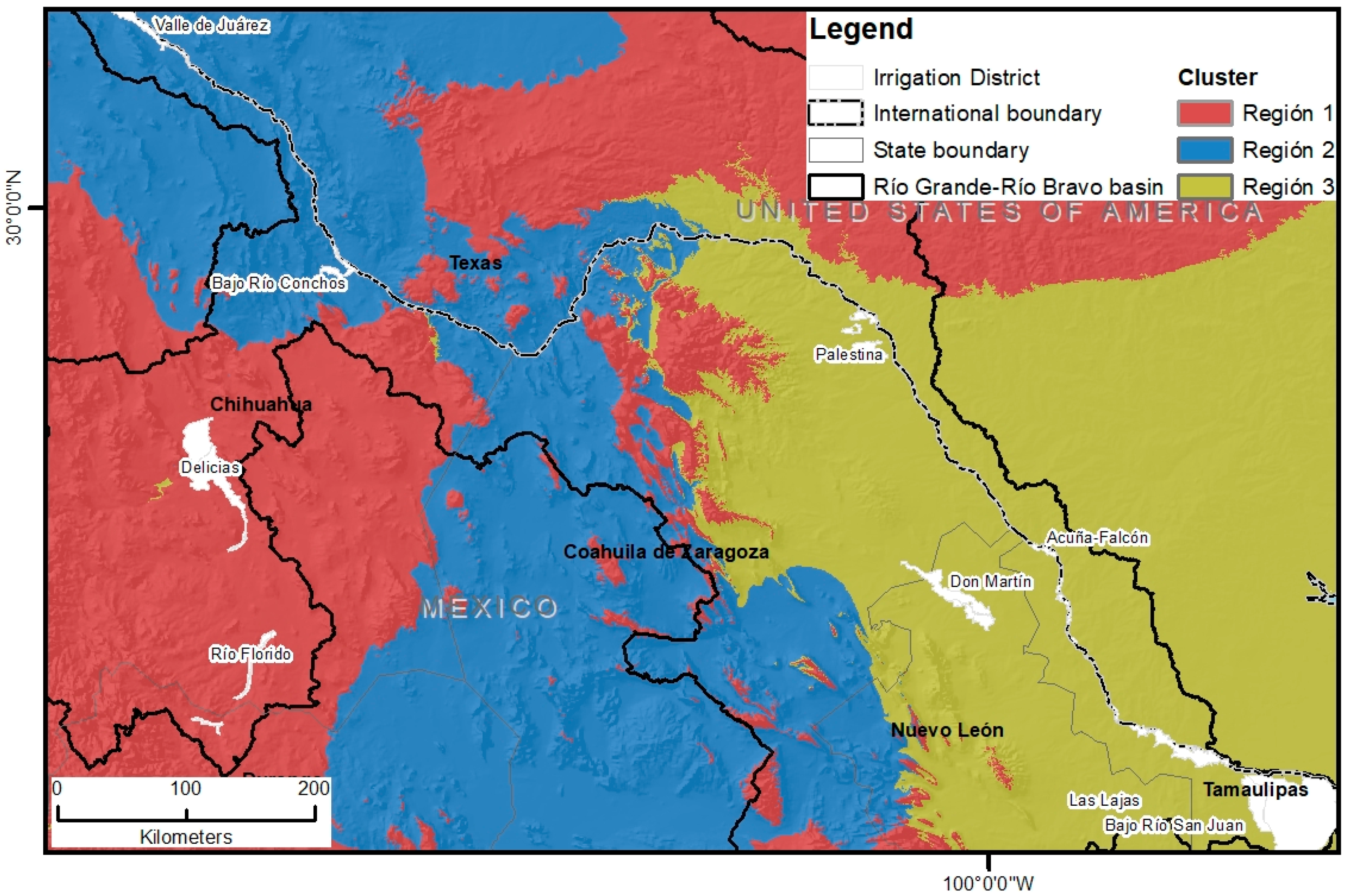
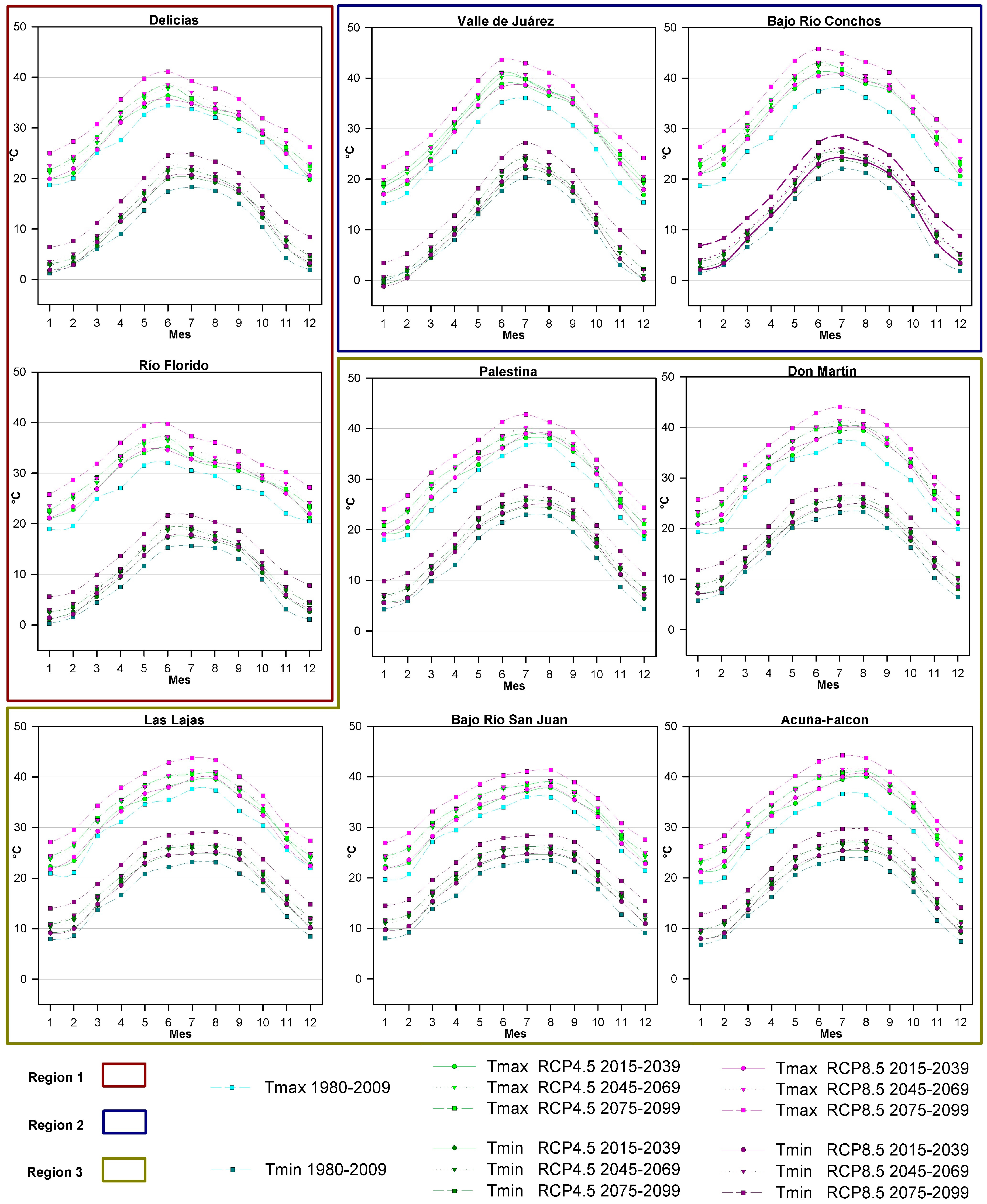
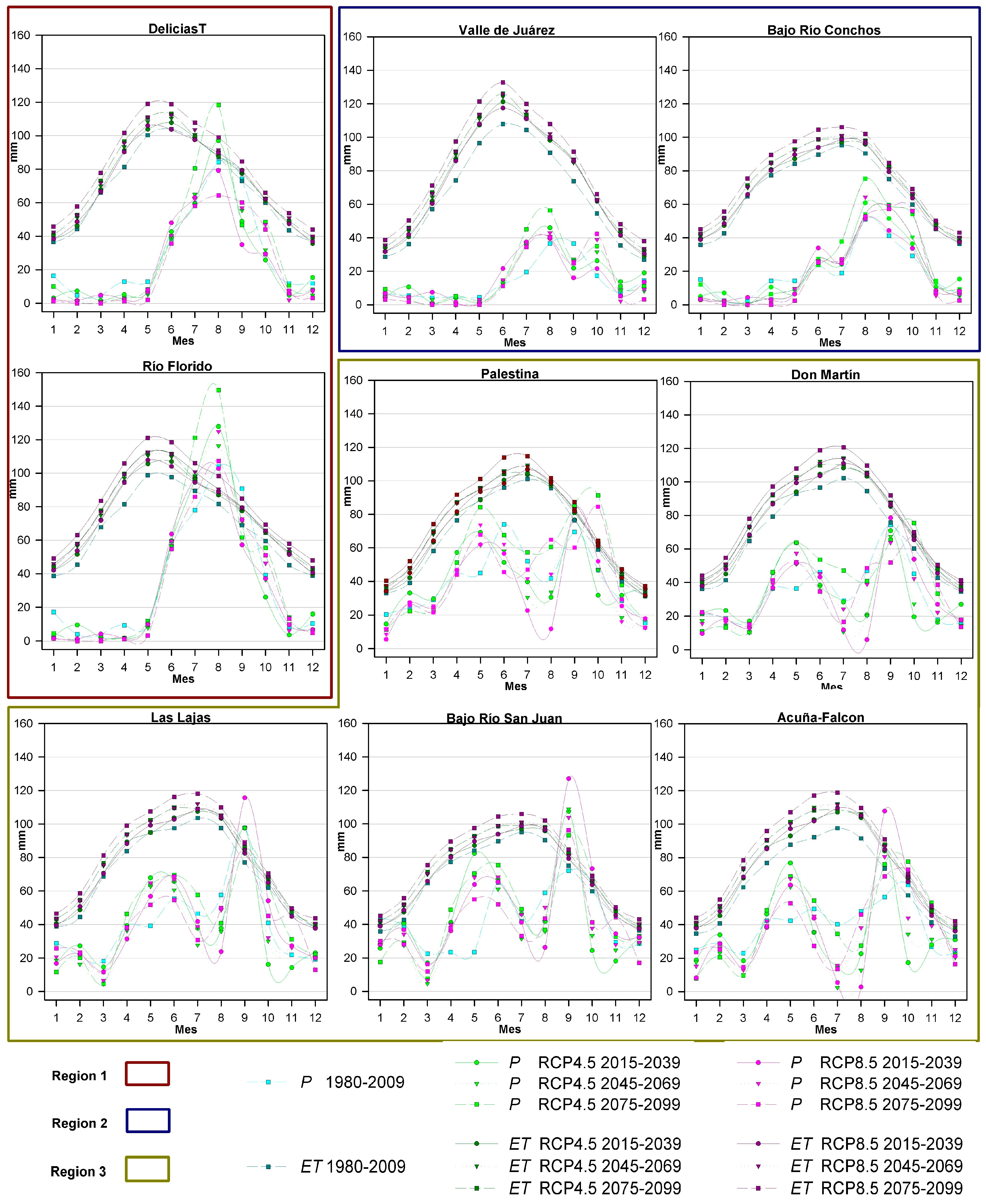
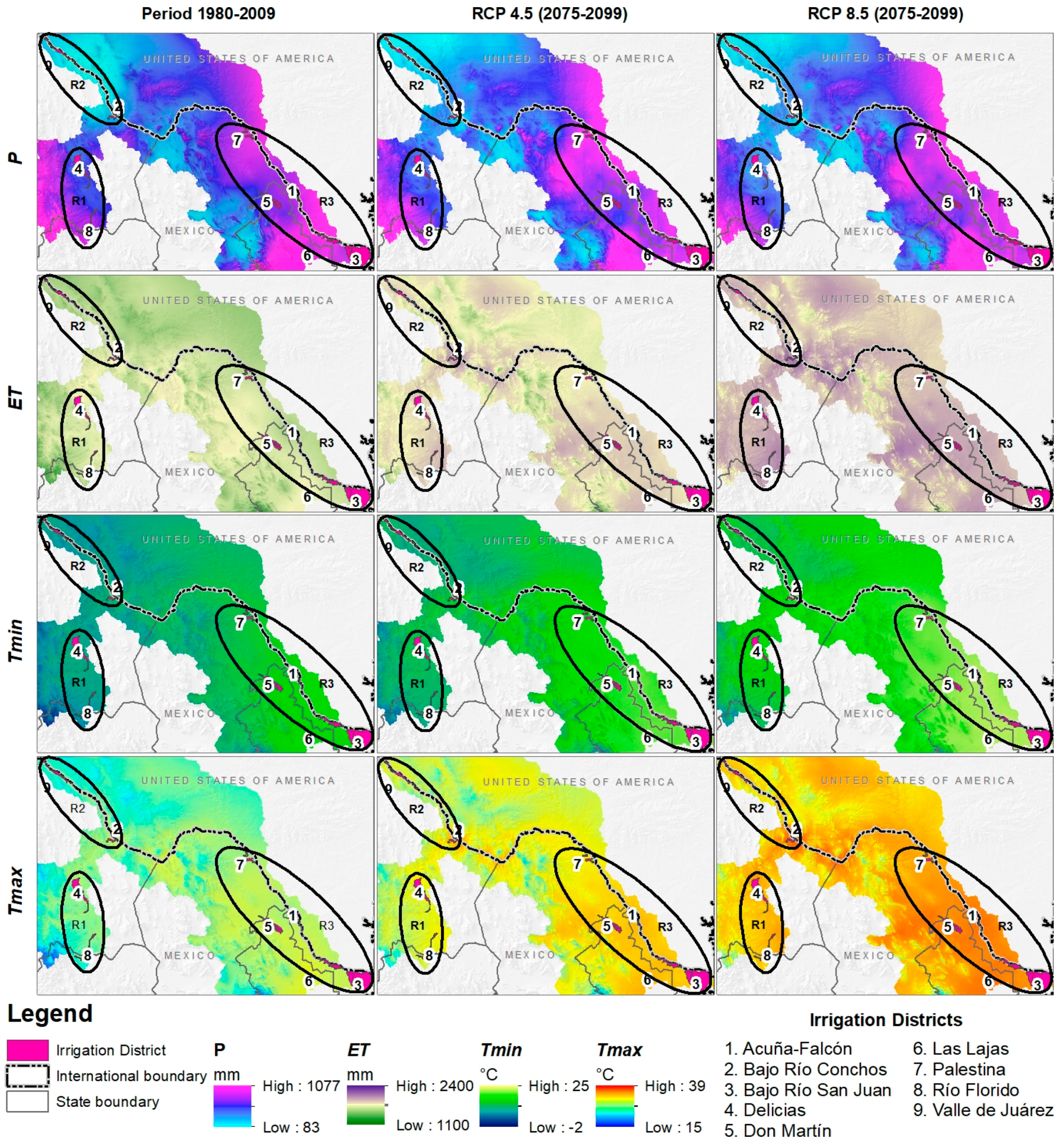
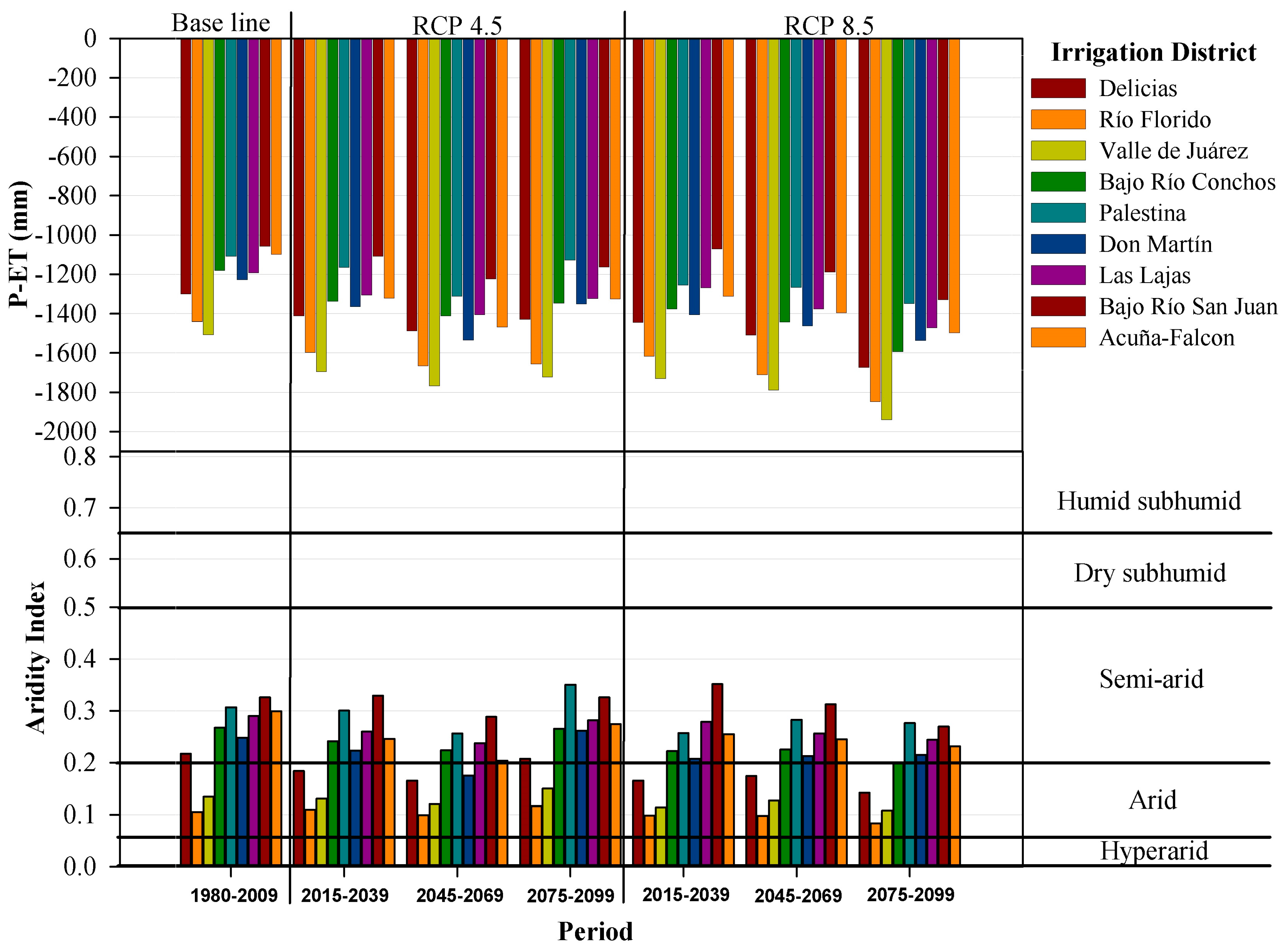
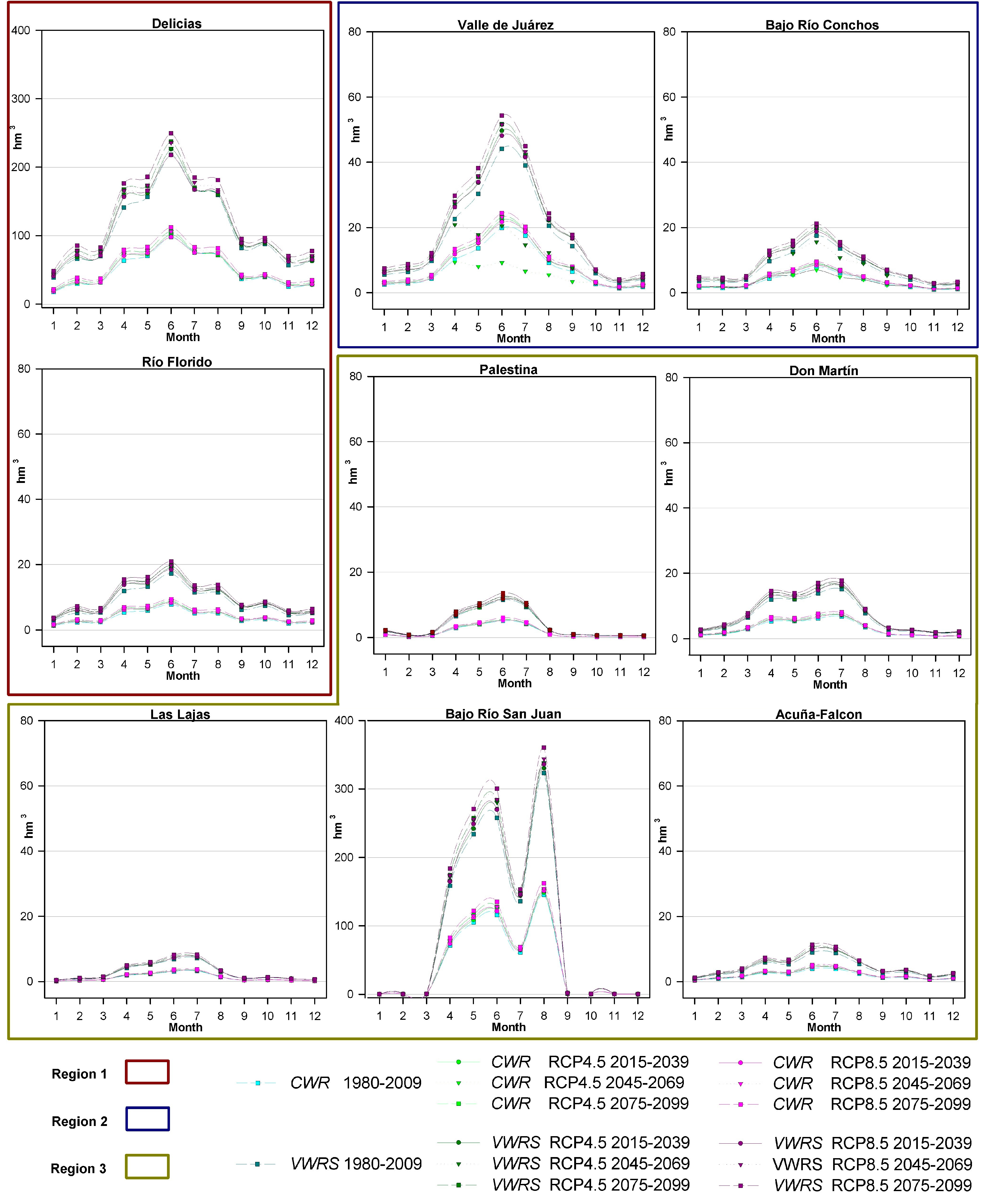
| Irrigation District | P | ET | Tmin | Tmax | CWR | P-ET | AI | Total | |||||||||||||
|---|---|---|---|---|---|---|---|---|---|---|---|---|---|---|---|---|---|---|---|---|---|
| Diff. mm | R. | Diff. mm | R. | Diff. °C | R. | Diff. °C | R. | Diff. hm3 | R. | Base | 2100 | Diff. mm | R. | Base | 2100 | Diff. | R. | Sum | R. | ||
| RCP 4.5 | Delicias | 13.54 | 9 | 143.0 | 2 | 2.91 | 2 | 3.18 | 1 | 49.44 | 9 | −1300.2 | −1429.7 | 129.46 | 5 | 0.22 | 0.21 | −0.01 | 8 | 36 | 4 |
| Valle de Juárez | 48.56 | 6 | 264.0 | 8 | 2.34 | 1 | 4.69 | 7 | 14.52 | 7 | −1440.6 | −1656.1 | 215.51 | 8 | 0.11 | 0.12 | 0.01 | 4 | 41 | 7 | |
| Bajo Río Conchos | 70.31 | 3 | 284.5 | 9 | 3.30 | 6 | 5.16 | 9 | 6.33 | 6 | −1507.3 | −1721.6 | 214.24 | 7 | 0.13 | 0.15 | 0.02 | 2 | 42 | 8 | |
| Río Florido | 55.47 | 4 | 222.0 | 6 | 3.00 | 3 | 4.21 | 6 | 6.29 | 5 | −1179.7 | −1346.3 | 166.53 | 6 | 0.27 | 0.27 | 0.00 | 6 | 36 | 5 | |
| Palestina | 117.41 | 1 | 137.1 | 1 | 3.34 | 5 | 3.43 | 2 | 1.66 | 2 | −1108.8 | −1128.5 | 19.69 | 1 | 0.31 | 0.35 | 0.04 | 1 | 13 | 1 | |
| Don Martín | 73.25 | 2 | 196.5 | 5 | 3.13 | 4 | 3.92 | 5 | 4.37 | 4 | −1228.1 | −1351.3 | 123.29 | 3 | 0.25 | 0.26 | 0.01 | 3 | 26 | 2 | |
| Las Lajas | 31.30 | 8 | 160.5 | 4 | 3.49 | 9 | 3.69 | 3 | 1.36 | 1 | −1193.1 | −1322.4 | 129.29 | 4 | 0.29 | 0.28 | −0.01 | 7 | 36 | 6 | |
| Bajo Río San Juan | 50.83 | 5 | 155.8 | 3 | 3.45 | 7 | 3.76 | 4 | 41.09 | 8 | −1057.7 | −1162.7 | 104.97 | 2 | 0.33 | 0.33 | 0.00 | 5 | 34 | 3 | |
| Acuña-Falcon | 31.63 | 7 | 258.7 | 7 | 3.36 | 8 | 4.84 | 8 | 3.62 | 3 | −1098.6 | −1325.7 | 227.09 | 9 | 0.30 | 0.27 | −0.03 | 9 | 51 | 9 | |
| RCP 8.5 | Delicias | −83.60 | 9 | 289.1 | 4 | 6.11 | 7 | 6.39 | 4 | 100.82 | 9 | −1300.2 | −1673.0 | 372.72 | 5 | 0.22 | 0.14 | −0.08 | 9 | 47 | 9 |
| Valle de Juárez | −2.70 | 4 | 404.6 | 8 | 5.39 | 1 | 7.76 | 8 | 22.04 | 7 | −1440.6 | −1847.9 | 407.31 | 7 | 0.11 | 0.08 | −0.02 | 1 | 36 | 5 | |
| Bajo Río Conchos | 1.09 | 3 | 434.0 | 9 | 6.38 | 9 | 8.34 | 9 | 9.61 | 5 | −1507.3 | −1940.3 | 432.99 | 9 | 0.13 | 0.11 | −0.03 | 2 | 46 | 8 | |
| Río Florido | −35.01 | 8 | 378.8 | 6 | 5.90 | 4 | 7.35 | 6 | 10.72 | 6 | −1179.7 | −1593.6 | 413.86 | 8 | 0.27 | 0.20 | −0.07 | 8 | 46 | 7 | |
| Palestina | 23.97 | 1 | 264.1 | 2 | 5.99 | 5 | 6.30 | 2 | 3.39 | 2 | −1108.8 | −1349.0 | 240.15 | 1 | 0.31 | 0.28 | −0.03 | 3 | 16 | 1 | |
| Don Martín | 15.88 | 2 | 324.3 | 5 | 5.84 | 2 | 6.78 | 5 | 7.33 | 4 | −1228.1 | −1536.5 | 308.42 | 4 | 0.25 | 0.21 | −0.03 | 4 | 26 | 2 | |
| Las Lajas | −11.70 | 5 | 266.9 | 3 | 6.18 | 8 | 6.34 | 3 | 2.34 | 1 | −1193.1 | −1471.7 | 278.68 | 3 | 0.29 | 0.24 | −0.05 | 5 | 28 | 4 | |
| Bajo Río San Juan | −21.57 | 7 | 249.3 | 1 | 5.88 | 3 | 6.19 | 1 | 72.19 | 8 | −1057.7 | −1328.6 | 270.91 | 2 | 0.33 | 0.27 | −0.06 | 6 | 28 | 3 | |
| Acuña-Falcon | −17.71 | 6 | 381.1 | 7 | 6.06 | 6 | 7.67 | 7 | 5.45 | 3 | −1098.6 | −1497.5 | 398.81 | 6 | 0.30 | 0.23 | −0.07 | 7 | 42 | 6 | |
| Region | P (mm/decade) | ET (mm/decade) | Tmin (°C/decade) | Tmax (°C/decade) | CWR (hm3) | VWRS (hm3) | |
|---|---|---|---|---|---|---|---|
| 1980–2009 | 1 | 7.10 | 1.75 | −0.02 | 0.02 | 317.83 | 706.29 |
| 2 | 0.23 | 2.53 | 0.03 | 0.04 | 66.21 | 147.14 | |
| 3 | −0.92 | −0.97 | −0.02 | −0.02 | 119.11 | 264.68 | |
| RCP 4.5 | 1 | 3.4 | 18.25 | 0.29 | 0.37 | 345.70 (8.8%) * | 768.21 |
| 2 | 5.9 | 27.43 | 0.28 | 0.49 | 76.63 (15.7%) * | 170.30 | |
| 3 | 6.09 | 18.17 | 0.33 | 0.39 | 129.53 (8.7%) * | 287.84 | |
| RCP 8.5 | 1 | −5.93 | 33.39 | 0.60 | 0.69 | 373.60 (17.5%) * | 830.23 |
| 2 | −0.08 | 41.93 | 0.59 | 0.80 | 82.03 (23.9%) * | 182.30 | |
| 3 | −0.22 | 29.71 | 0.60 | 0.67 | 137.25 (15.2%) * | 304.99 |
© 2018 by the authors. Licensee MDPI, Basel, Switzerland. This article is an open access article distributed under the terms and conditions of the Creative Commons Attribution (CC BY) license (http://creativecommons.org/licenses/by/4.0/).
Share and Cite
Paredes-Tavares, J.; Gómez-Albores, M.A.; Mastachi-Loza, C.A.; Díaz-Delgado, C.; Becerril-Piña, R.; Martínez-Valdés, H.; Bâ, K.M. Impacts of Climate Change on the Irrigation Districts of the Rio Bravo Basin. Water 2018, 10, 258. https://doi.org/10.3390/w10030258
Paredes-Tavares J, Gómez-Albores MA, Mastachi-Loza CA, Díaz-Delgado C, Becerril-Piña R, Martínez-Valdés H, Bâ KM. Impacts of Climate Change on the Irrigation Districts of the Rio Bravo Basin. Water. 2018; 10(3):258. https://doi.org/10.3390/w10030258
Chicago/Turabian StyleParedes-Tavares, Jorge, Miguel Angel Gómez-Albores, Carlos Alberto Mastachi-Loza, Carlos Díaz-Delgado, Rocio Becerril-Piña, Héctor Martínez-Valdés, and Khalidou M. Bâ. 2018. "Impacts of Climate Change on the Irrigation Districts of the Rio Bravo Basin" Water 10, no. 3: 258. https://doi.org/10.3390/w10030258
APA StyleParedes-Tavares, J., Gómez-Albores, M. A., Mastachi-Loza, C. A., Díaz-Delgado, C., Becerril-Piña, R., Martínez-Valdés, H., & Bâ, K. M. (2018). Impacts of Climate Change on the Irrigation Districts of the Rio Bravo Basin. Water, 10(3), 258. https://doi.org/10.3390/w10030258




